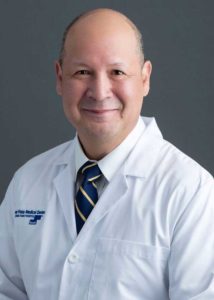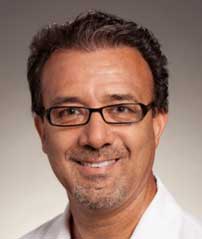Hispanic Heritage Month is a chance to recognize and celebrate the deep-rooted and impactful history, culture, and achievements of the Hispanic community.
As a physician-led network caring for some of the most underserved communities in America, we know that our diversity is our strength. Steward recognizes the socioeconomic and medical disparities affecting many of our Hispanic patients, including the disproportionate impact of COVID-19 and high-rates of heart-disease and diabetes.
We are especially grateful for our Hispanic team members who are committed to continuing to provide equal access to high-quality health care to all members of the Hispanic community. In honor of Hispanic Heritage Month, we spoke with two Hispanic Steward team members about their journey into medicine and how they’re working to address disparities and help our communities thrive.
Gregory Martinez, RN, MSN, CCRN, APRN-CNP, Texas Vista Medical Center
A native of the Southside of San Antonio, Gregory Martinez, RN, grew up just a few miles from where he now serves his community as a medical professional. He takes great pride in getting to know his patients and their families, while advocating for their health and well-being. With more than 28 years of experience as a nurse practitioner, Martinez has a true understanding of the needs of his patients. Martinez received his training at Texas A&M Corpus Christi in primary care medicine.
How did you get interested in medicine?
For many years, my mother worked for the U.S. Army Medical Center in Fort Sam, Texas. From a young age, I was intrigued by the home-medicine, pathophysiology side of the medical field, and I have followed that passion throughout my thirty-three year career.
Can you talk about the health disparities among Hispanic and non-Hispanic patients that you see?
There are major socioeconomic and health disparities across San Antonio. I have worked in the Southside of San Antonio, here at Texas Vista, and on the other side of San Antonio as well, in Encino, and the disparity between these populations is extreme in terms of education, income, and family dynamics.
In terms of medical inequities, high-rates of diabetes amongst Hispanic patients goes back to socioeconomic disparities. Since many Hispanic-Americans cannot afford certain types of lean protein, the Hispanic diet is often based on carbohydrates. This makes it difficult for many Hispanic-Americans to follow a well-controlled diet. Couple this with the fact that many of my Hispanic patients in the Southside have two jobs which often disrupts their breakfast and lunch schedules. These lifestyle factors play into my practice and care plan for my Hisapnic patients with diabetes.
How helpful is it to have bilingual medical staff?
It makes a huge difference to have bilingual nurses and physicians, especially in this part of San Antonio. The Hispanic population is a very grateful culture–when they say “I appreciate you,” they really mean it. So, if you make a concerted effort to try and communicate with Latino patients, it means a lot. Your Spanish may be off, but they appreciate it as a sign of respect.
How does the Hispanic community shape the Southside San Antonio community?
The Hispanic culture is grateful, proud, and deep. I start many of my conversations with patients by asking where they went to high school. We still eat at the same restaurants and know the same streets, we reminisce about the 60s and 70s in the Southside. People who are implanted here in the Southside, and raise their children here – we are very proud of where we come from.
In 2021, St. Joseph Medical Center launched the Latino Health Center of Excellence to better serve its growing population of Hispanic patients. All of the personnel within the Latino Health Center speak Spanish, with the hopes of making this patient population more comfortable and confident in the medical care they are receiving. Additionally, the Latino Health Center caters to the needs of its patients by offering a dietary menu that reflects the Hispanic culture and providing access to TV programming in Spanish. St. Joseph Medical Center is the only hospital in the downtown Houston area that provides the Hispanic population this offering.
Juan Barriga, MD, Latino Health Center of Excellence at St. Joseph Medical Center
Juan Barriga, MD, a pulmonologist and critical care physician serves as a hospitalist and intensivist, taking care of some of our most critically ill patients – often in the Intensive Care Unit. Dr. Barriga attended medical school at the Universidad Central Del Ecuador and has been practicing medicine for over 30 years.
How did you enter the medical field?
I have been interested in medicine my whole life. When I was little, when I played pretend, I never played a superhero or a police officer, I always played a doctor. So that dream was in me from day one.
What inspired you to come practice in Houston?
After I received my medical degree, I chose to come to Houston to serve a majority-Hispanic, Spanish-speaking community. For me, it is deeply rewarding, and a blessing to be able to serve my Hispanic community through my work in medicine.
What was it like caring for Hispanic patients during the COVID-19 pandemic?
I have been in the ICU since day one of the pandemic – and it was clear, in the various hospitals that I worked in, that 90% of my COVID patients were Hispanic, overweight, male, and often suffering from pre-existing conditions common throughout the Hispanic community, such as diabetes and hypertension. Because of this, I always encourage my Hispanic patients to get vaccinated and boosted to protect themselves against the virus.
Can you describe the impact of the Latino Health Center of Excellence?
The greatest impact of the Latino Health Center of Excellence is being able to provide my Hispanic patients with the best care possible. Through the Latino Health Center, Hispanic patients are able to see doctors who can explain in detail, with hope, compassion, and empathy, what they are facing and how we can help them. I am able to communicate in the same language and culture what is best for them, and make sure nothing gets lost in translation. I see, day-to-day, how much of a difference this makes when a patient comes to me after seeing a doctor who does not speak Spanish – they often have no clue what they have or how they are supposed to handle it. Through the Latino Health Center, I am able to help Spanish-speaking patients understand what they are going through, give them advice, and help them the best way I can. It’s an incredibly rewarding feeling.
To find a doctor or schedule an appointment, visit Steward DoctorFinder™.




